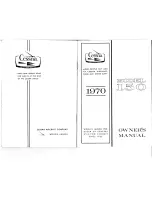
under CAR 3) as two-pilot transport category
aircraft. They are certified for operation to an
altitude of 41,000, 45,000, or 51,000 feet, de-
pending on serial number and equipment in-
stallation. Figure 1-1 shows a Learjet 25.
The terms “early” and “late” are frequently
used in the chapters of this training manual
with reference to airplane models. This is to
simplify explanations for the two basic groups
of airplanes. Table 1-1 lists the early- and
late-model groups by airplane serial number
for reference.
STRUCTURES
GENERAL
Most of the airplane structures are fabricated of
high-strength aluminum alloy, with steel, glass
fiber, and other materials used as needed. During
testing, all load-bearing members and surfaces
demonstrated the capability to carry 90% of the
“G” forces with an adjacent structural compo-
nent failed. The airplane structure consists of
fuselage, wings, and empennage. The discussion
on the fuselage includes the doors and windows.
General dimensions are shown in Figure 1-2.
1-2
FOR TRAINING PURPOSES ONLY
LEARJET 20 SERIES PILOT TRAINING MANUAL
FlightSafety
international
Figure 1-1. Learjet 25
Table 1-1. LEARJET 20 SERIES MODELS AND SERIALIZATION
MODEL
MODEL
SERIAL BLOCK
SERIAL BLOCK
LATE
EARLY
23
24
24B
25
24D
24E
24F
25B
25C
25D
23-003 THROUGH 23-099
24-100 THROUGH 24-180
24-181 THROUGH 24-229 EXCEPT 24-218
25-002 THROUGH 25-064 EXCEPT 25-061
24-218, 24-230 THROUGH 24-328
24-329 AND SUBSEQUENT
24-329 AND SUBSEQUENT
25-061, 25-070 THROUGH 25-205
25-061, 25-070 THROUGH 25-205
25-206 AND SUBSEQUENT









































